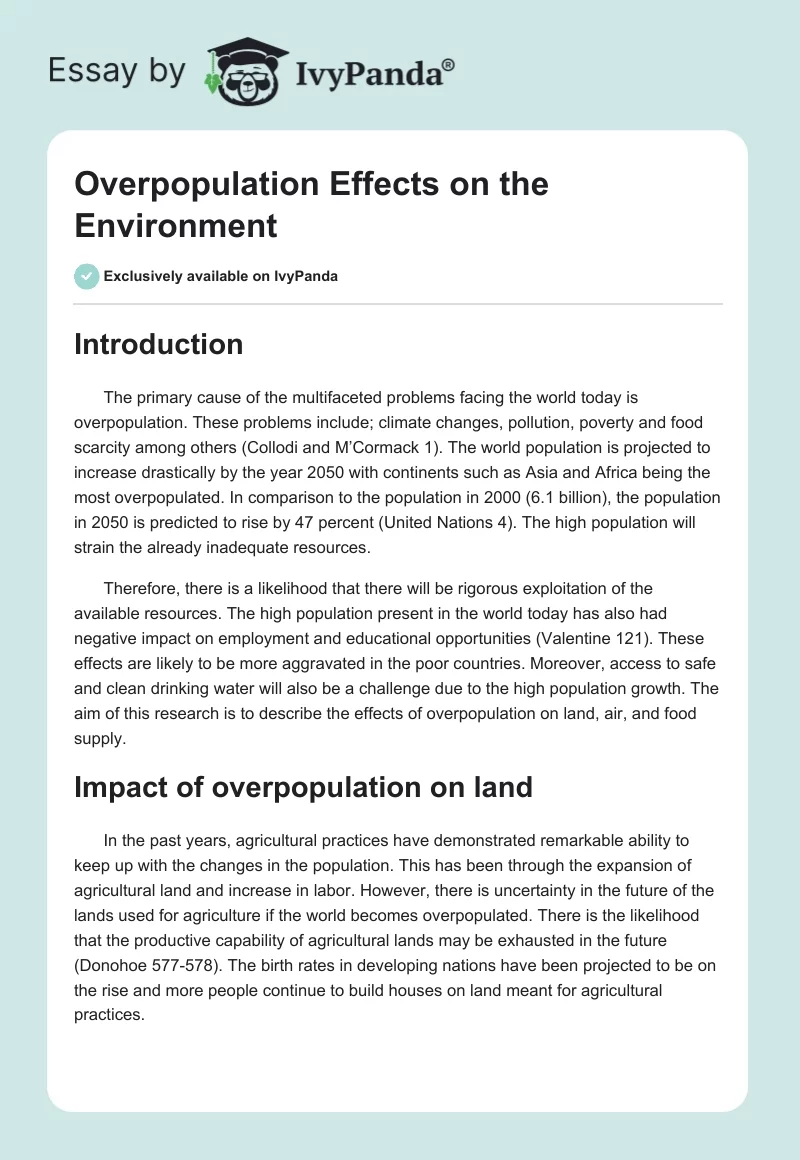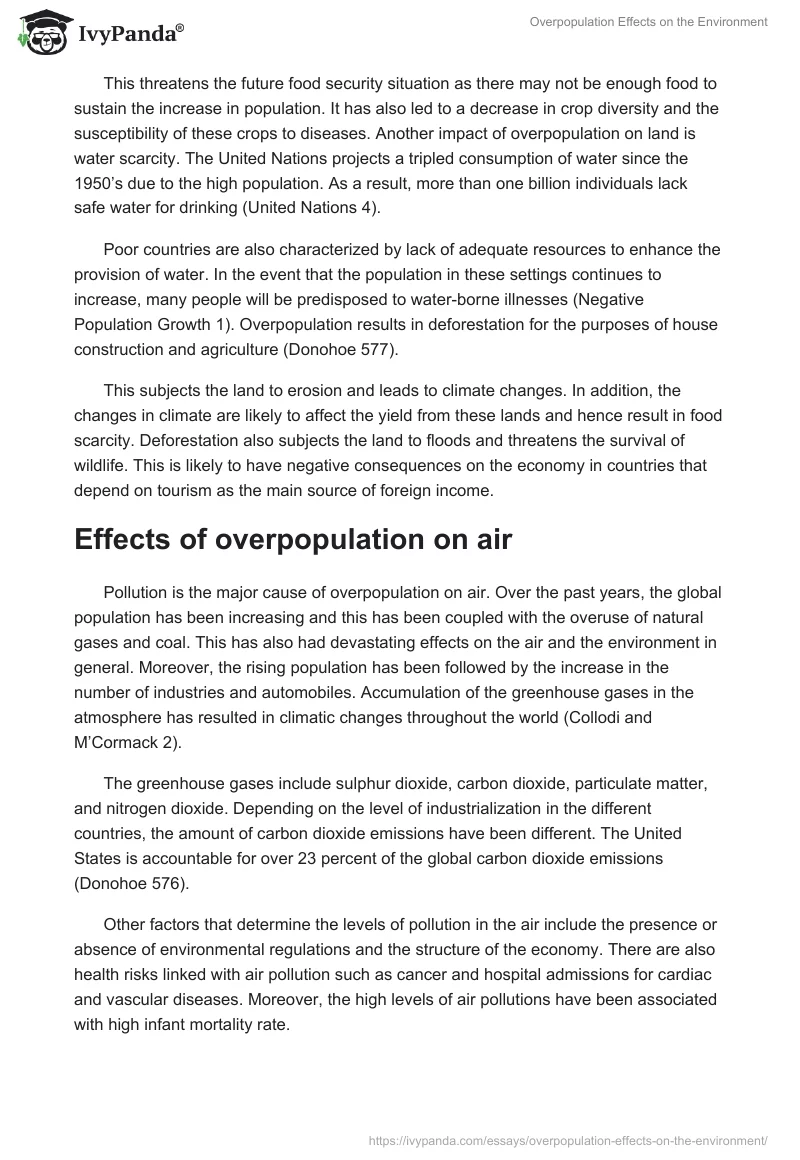Introduction
The primary cause of the multifaceted problems facing the world today is overpopulation. These problems include; climate changes, pollution, poverty and food scarcity among others (Collodi and M’Cormack 1). The world population is projected to increase drastically by the year 2050 with continents such as Asia and Africa being the most overpopulated. In comparison to the population in 2000 (6.1 billion), the population in 2050 is predicted to rise by 47 percent (United Nations 4). The high population will strain the already inadequate resources.
Therefore, there is a likelihood that there will be rigorous exploitation of the available resources. The high population present in the world today has also had negative impact on employment and educational opportunities (Valentine 121). These effects are likely to be more aggravated in the poor countries. Moreover, access to safe and clean drinking water will also be a challenge due to the high population growth. The aim of this research is to describe the effects of overpopulation on land, air, and food supply.
Impact of overpopulation on land
In the past years, agricultural practices have demonstrated remarkable ability to keep up with the changes in the population. This has been through the expansion of agricultural land and increase in labor. However, there is uncertainty in the future of the lands used for agriculture if the world becomes overpopulated. There is the likelihood that the productive capability of agricultural lands may be exhausted in the future (Donohoe 577-578). The birth rates in developing nations have been projected to be on the rise and more people continue to build houses on land meant for agricultural practices.
This threatens the future food security situation as there may not be enough food to sustain the increase in population. It has also led to a decrease in crop diversity and the susceptibility of these crops to diseases. Another impact of overpopulation on land is water scarcity. The United Nations projects a tripled consumption of water since the 1950’s due to the high population. As a result, more than one billion individuals lack safe water for drinking (United Nations 4).
Poor countries are also characterized by lack of adequate resources to enhance the provision of water. In the event that the population in these settings continues to increase, many people will be predisposed to water-borne illnesses (Negative Population Growth 1). Overpopulation results in deforestation for the purposes of house construction and agriculture (Donohoe 577).
This subjects the land to erosion and leads to climate changes. In addition, the changes in climate are likely to affect the yield from these lands and hence result in food scarcity. Deforestation also subjects the land to floods and threatens the survival of wildlife. This is likely to have negative consequences on the economy in countries that depend on tourism as the main source of foreign income.
Effects of overpopulation on air
Pollution is the major cause of overpopulation on air. Over the past years, the global population has been increasing and this has been coupled with the overuse of natural gases and coal. This has also had devastating effects on the air and the environment in general. Moreover, the rising population has been followed by the increase in the number of industries and automobiles. Accumulation of the greenhouse gases in the atmosphere has resulted in climatic changes throughout the world (Collodi and M’Cormack 2).
The greenhouse gases include sulphur dioxide, carbon dioxide, particulate matter, and nitrogen dioxide. Depending on the level of industrialization in the different countries, the amount of carbon dioxide emissions have been different. The United States is accountable for over 23 percent of the global carbon dioxide emissions (Donohoe 576).
Other factors that determine the levels of pollution in the air include the presence or absence of environmental regulations and the structure of the economy. There are also health risks linked with air pollution such as cancer and hospital admissions for cardiac and vascular diseases. Moreover, the high levels of air pollutions have been associated with high infant mortality rate.
Overpopulation and food security
Overpopulation has been reported to have devastating effects on the global food security (Collodi and M’Cormack 3). As a result of the rise in population in the past decades there has been a high demand for food. Therefore, the amount of food produced on a global scale has increased and this has been sustained by practices such as irrigation and the creation of new lands for farming. Majority of the new lands have been created through deforestation. The amount of food produced by 2050 will be 25 percent less and unable to sustain the global population (Collodi and M’Cormack 3).
Other factors that will be coupled by the population growth include land degradation, water scarcity, and climate changes. Moreover, the rise in the number of agricultural activities has led to loss of fresh water meant for human consumption. Based on the threats facing the global arable land today, agricultural activities will not be sufficient to cater for the overpopulation. Continents such as Asia and Africa are currently experiencing the effects of overpopulation (Population Action International 2).
These continents are characterized by hunger and famine. The diminished food security has been associated with climatic changes and the lack of alternative ways of producing food. Furthermore, overpopulation is likely to shift food consumption toward animal products that are more expensive. Majority of the poor nations may not have adequate resources to shift to animal production and this may result in more famine nad hunger.
Furthermore, these countries have been reported to have the highest fertility rates. An example of the regions currently characterized by food insecurity include Sub-Saharan Africa. The population in this region is predicted to be double of what it is today by the year 2050. Unless the current food shortages are dealt with, many people will end up dying due hunger and famine.
Conclusion
The global population has been on the increase in the past several decades. As a result, there have been negative effects on the land, air and food supply as identified in this paper. Overpopulation has negative effect on land due to overuse of agricultural land and deforestation. More land meant for farming is likely to be converted to urban housing to accommodate the population.
Moreover, the high population has a negative impact on air as evidenced by the global climatic changes.. Additionally, the global food security is under threat due to the increase in population (Population Action International 2). These findings indicate that overpopulation has negative impacts on all the aforementioned factors.
Governments should focus on developing ways of sustaining the rise in population to avoid the devastating effects associated with the same. Stakeholders in the different nations should focus on introducing mechanisms to educate the citizens on the effects of high population growth (United Nations 5). Moreover, the introduction of laws and policies that focus on reducing the birth rates in developing countries would ensure that the populations are controlled early enough. Lastly, more research is required to develop ways to improve the food security situation in Africa and Asia.
Works Cited
Collodi, Jason and Freida, M’Cormack 2009, Population Growth, Environment and Food Security: What Does the Future Hold?. PDF file.
Donohoe, Martin. “Causes and health consequences of environmental degradation and social injustice.” Social Science & Medicine 56.13 (2003): 573–587.Science Direct.
Negative Population Growth, 2013, Effects of Overpopulation: Water and Air Pollution. PDF file.
Population Action International, 2011, Why Population Matters to Food Security. PDF file.
United Nations, 2004, World Population to 2300. PDF file.
Valentine, Scott Victor. “Disarming the population bomb.” International Journal of Sustainable Development & World Ecology 17.2 (2010): 120-132. ResearchGate.


